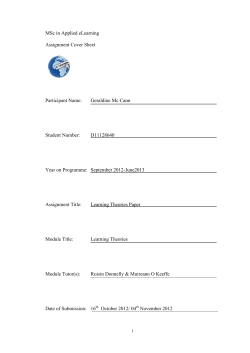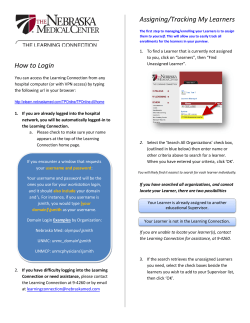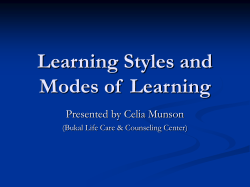
Assessment Methods This handout will cover: ⢠What is assessment
Assessment Methods This handout will cover: • • • • • • • • • What is assessment? Formative and summative assessment How can you choose which methods to use? Assessment methods: informal and formal Peer and self assessment Internal and external assessment requirements Meeting individual needs Reading list Website list What is assessment? Assessment is a way of finding out if learning has taken place, it is a process of making a decision regarding your learner’s knowledge and/or performance against set criteria. If learning has taken place, there will be a change in behaviour i.e. the demonstration of new skills, knowledge, attitudes, and understanding. Assessment can take place before or when a learner commences, whilst they are progressing, and when they complete their learning programme. These are known as assessment types and are often carried out formatively and summatively. Formative and summative assessment Formative assessment checks ongoing progress, usually by informal methods devised by the assessor. Summative assessment confirms achievement (or not) usually by formal methods devised by an awarding organisation. All methods used should enable the learner to produce valid, authentic, current, sufficient and reliable evidence (VACSR). For example: Valid – the assessment process and work produced by the learner is appropriate and relevant. Authentic – the work has been produced solely by the learner. Current – the work is still relevant at the time of assessment. Sufficient – the work covers all the assessment requirements. Reliable – the work is consistent and at the required level i.e. if the assessment was carried out again with similar learners, similar results would be achieved. Examples of formative assessment methods are using questions, quizzes, discussions etc. This is known as assessment for learning as it prepares learners for formal assessment. C9020 (V1) - Copyright Ann Gravells - www.anngravells.co.uk Gravells A & Simpson S (2014) The Certificate in Education and Training London Learning Matters SAGE Page 1 of 4 Examples of summative assessment methods are using tests, exams, assignments, observations etc. This is known as assessment of learning as it assesses learning has taken place. How can you choose which methods to use? There are many methods you can use to assess your learners, these will depend upon what you are assessing and where. They can be informal to check ongoing progress and/or formal to confirm achievement. The methods you choose will be influenced by whether you are assessing vocational skills or academic knowledge. If learners are assessing towards an accredited programme, the assessment methods are often stated in the qualification handbook or syllabus. Assessment activities such as assignments might also be provided along with guidance towards decision making and grading. If none are provided, you will have to devise activities based upon the requirements of the programme or what is being assessed. Assessment methods Assessment methods are different to assessment types, a method is how the assessment type will be used e.g. questions for initial assessment, observation for formative assessment, an exam for summative assessment etc. The method can be formal or informal, formal methods count towards achievement whereas informal methods check ongoing progress. Sometimes, informal methods could also be formal methods depending on the situation. Formal assessment methods • assignments • case studies • essays • exams • observations • oral and written questions • projects • recognition of prior learning • reviewing work products/learner evidence • skills or knowledge tests • use of others e.g. witness statements Informal assessment methods • discussions • gapped handouts (sentences with missing words) • group work • journals/diaries • puzzles • quizzes • role plays • word searches If you are assessing a programme where the assessment activities are provided, for example tests or exams, there is often the tendency to teach purely what is required to achieve a pass. Learners may therefore not gain valuable additional skills and knowledge. Teaching to pass tests does not maximise a learners’ ability and potential. C9020 (V1) - Copyright Ann Gravells - www.anngravells.co.uk Gravells A & Simpson S (2014) The Certificate in Education and Training London Learning Matters SAGE Page 2 of 4 Peer and self assessment Peer-assessment involves a learner assessing another learner’s progress. Selfassessment involves a learner assessing their own progress. Both methods encourage learners to make decisions about what has been learnt so far, take responsibility for their learning and become involved with the assessment process. Your learners will need to fully understand what needs to be assessed, and how to be fair and objective with their decisions and any feedback given to others. Throughout the process of peer and self-assessment, learners can develop skills such as listening, observing and questioning. The results of peer and selfassessment are usually not counted towards meeting the requirements of a qualification as you should make the final decision regarding achievement. However, in the workplace, peer-assessment might be counted as proof the learner has met the requirements of a job role, for example, if the peer is a colleague. Internal and external assessment requirements Internal relate to those within your organisation, such as checking a learner’s work for plagiarism and ensuring it is authentic. External relate to those from other organisations such as the time limit within which learners must be registered with an awarding organisation. Polices and procedures Procedures must always be followed. For example, if you suspect plagiarism, you must follow your organisation’s policy. This might require you to talk to your learner first and establish the facts, before taking it further. Examples include: • • • • • • • • • • • • access and fair assessment appeals authenticity complaints confidentiality of information copyright and data protection equality and diversity health and safety observation of teaching, learning and assessment quality assurance plagiarism safeguarding Meeting individual needs If you have learners with any particular needs or requirements, you should consider how you can help meet these. Always check with your organisation regarding what C9020 (V1) - Copyright Ann Gravells - www.anngravells.co.uk Gravells A & Simpson S (2014) The Certificate in Education and Training London Learning Matters SAGE Page 3 of 4 you can and can’t do as you may need approval to make any reasonable adjustments. Some examples of meeting your learners’ needs include: adapting or providing resources and equipment for a learner who is partially sighted adapting the environment for a learner who is physically disabled allowing extra time for a learner with dyslexia or dyscalculia changing the date and/or time for a learner who works shifts providing specialist support staff to improve English and maths skills providing the assessment information in an alternative format such as spoken instead of written for a learner who has impaired vision using a different location which is more accessible to learners who have to travel far Reading list Gravells A (2014) Achieving your Assessment and Quality Assurance Units (TAQA) London Learning Matters SAGE Gravells A & Simpson S (2014) The Certificate in Education and Training London Learning Matters SAGE Gravells A & Simpson S (2014) Passing Assessments for the Certificate in Education and Training London Learning Matters SAGE Read H (2011) The Best Assessor’s Guide Bideford Read On Publications Ltd Tummons J (2011) Assessing Learning in the Lifelong Learning Sector (3rd Edn) Exeter Learning Matters Wilson (2012) Practical Teaching: A Guide to Assessment and Quality Assurance Hampshire Cengage Learning Website list Assessment resources – www.excellencegateway.org.uk Chartered Institute for Educational Assessors – www.ciea.org.uk Developing Assessment Feedback - http://escalate.ac.uk/4147 Initial Assessment Tools – www.toolslibrary.co.uk Learning Preferences – www.vark-learn.com Literacy and Numeracy online tests – www.move-on.org.uk Assessment - http://www.brookes.ac.uk/services/ocsld/resources/assessment.html C9020 (V1) - Copyright Ann Gravells - www.anngravells.co.uk Gravells A & Simpson S (2014) The Certificate in Education and Training London Learning Matters SAGE Page 4 of 4
© Copyright 2025














